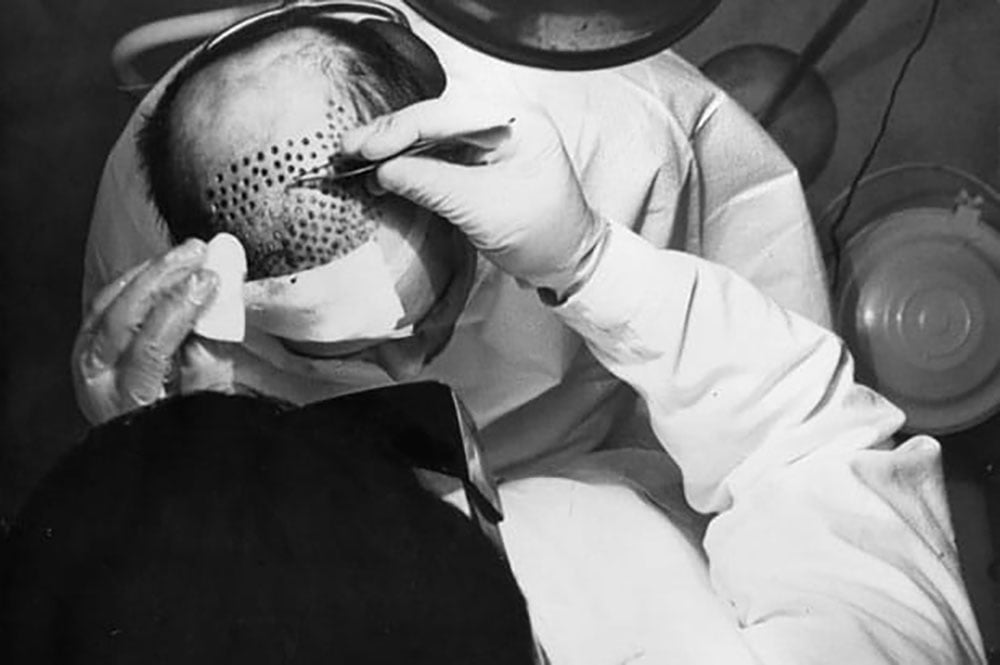The History of Hair Transplant

The History of Hair Transplant
Hair transplant procedures have come a long way in recent decades. The results surgeons can get with the new areas of hair on a
patient’s previously balding areas are better than they have ever been before. It is amazing that this first started with a doctor who wanted to transplant hair to give people new eyebrows.
Dr. Okuda of Japan was busy trying to transplant hair to the eyelashes and eyebrows of people who had lost them traumatically.
This was before World War II. When the war broke out, his discovery of hair transplant procedures was squelched until two decades later.
In 1959, Dr. Norman Orentreich began a new field of surgery when he published on the use of hair transplant surgery.
It was during this decade that doctors had begun to try moving balding-proof hair follicles to the balding areas of patients’ heads. They used hair from the fringe, or back and sides of the head, to accomplish this.
The doctors were trying to determine whether hair follicles were balding resistant because of where they were located on the head or
because of something inherent in the follicles themselves. This would settle the issue of whether hair transplant would work by those methods.
After their trials, they got the answer: the hair follicles themselves made the difference in the life of the hair and not where they were placed on the scalp.
They termed this phenomenon Donor Dominance. Hair transplant surgery was on the horizon.
Doctors started doing hair transplant procedures immediately. They began with a method that was somewhat flawed.
While they did use their idea about moving hair from the sides and back of the head to the balding areas, they did not have pleasing results.
These hair transplant procedures in the 1960s and 1970s used a method where 15-25 hairs were grafted in a round plug pattern.
These plugs were both conspicuous and unsightly. They looked quite unnatural; if a person had hair plugs, everyone knew it. They were not only unbecoming, they were also permanent.
Improvements were made in hair transplant surgery in the 1980s. Mini-grafts were better, but they still had the appearance of plugs,
albeit smaller plugs. These were made up of 5-8 hairs each. This size of plugs is still being used by some surgeons even today.
As time has gone by, the graft used by most surgeons has gone down. The hair transplant of grafts between 1-8 hairs is the norm.
Up to 800 grafts can be done in one sitting now. There is still room for improvement, though, as the results still do not look completely natural as they should.
A new method of hair transplant that is being used by some doctors today is follicle-unit micro-grafting. In this procedure, grafts are made up of 1-4 hairs and are placed over the balding area.
This is the usual number of hairs in follicles on a healthy head of hair. By inserting thousands of these follicular units, surgeons can give the appearance of natural hair and hairline.
Hair transplant surgery has reached a level where it can produce a result that is virtually undetectable to most people.
Over the course of several decades, it has changed from an experimental procedure to one that is used frequently and successfully.
Who Needs A Hair Transplant?
At some point in life, many people may have to deal with the frustrating ordeal of loosing their hair. It is some thing that no one wants to go through, but may be inevitable for a lot of people.
Some people that may experience loosing their hair as they get older and there are some have to deal with it much earlier in life. No matter when this problem occurs, it is up to them to figure out a way to make them feel better about the situation.
One way to take care of this hair loss problem is to have a hair transplant. This is a procedure where new hair is transplanted where the old hair has begun to fall out.
This fix can be used on anyone of any age. No matter what type of hair loss problem the person has, getting a transplant may be the best way to get the hair back that they want so badly.
Many children even have to deal with the pain of loosing their hair. They may loose it because of a vitamin deficiency or even an illness.
When this problem occurs, it is a good idea for the child to get as much help as they possibly can. This way they will feel better and not have to worry about being teased about their hair loss. A hair transplant may be some thing that they can have done.
In order to have a hair transplant, the person is going to have to see a dermatologist. They will give them the knowledge of everything that they are going to have to know to get the proper transplant for them.
It is important to have the right information by the right doctor so that there are no potential problems with the transplant.
Many, women and men, have to deal with premature hair loss at some point in their lives. When this is the case, it is important for them to know that they can get help with this problem so that they can feel good again.
For many people, it is very depressing to know that their hair is falling out and that they are getting older. By having a transplant, these people will have the opportunity of getting their hair back and looking and feeling good again.
Most of the time, a hair transplant is successful. For many people getting a hair transplant is easy and painless. There are usually no complications to have to deal with when getting a hair transplant.
The hair will usually grow and look as natural as your original hair did. No one will ever know that you have had a transplant and you will never have to tell anyone your secret. This is the best part about having one of these hair transplants done.
Planning for Your Hair Transplant Surgery
It takes courage to take the first steps in going through with hair transplant surgery. Planning for the procedure is necessary before you even make the final decision to have it done.
Once that step is completed, you will be ready to start the preparations for your surgery.
Before you are approved for a hair transplant procedure, the doctor will have to sign off on you. You must be deemed appropriate for the surgery. It may seem that everyone would be approved, but there are several reasons why you may not be.
The doctor will explore both the hair loss you have suffered, and the hair growth you still have. This is very important, because knowing where the donor hair for the hair transplant will come from is imperative.
The doctor will also want to know the patterns of baldness and hair growth in your family history. This will give an idea of whether
there is hope for a good result that will last for a fair amount of time. You will also need to reveal to the doctor if you have had any hair replacement surgery before.
To get an idea of how you will react to having a hair transplant procedure done, the doctor will ask many questions. He will want to know the basics of your lifestyle as they relate to your health and hair.
The doctor will also want to know what you think will change when you have your hair transplant. If your expectations are too high,
you may be referred to counseling before a reputable doctor will perform a hair transplant. If you are positive yet realistic, you may be ready for the next step.
Next, the doctor will get all the facts on your health that are related with surgical procedures. Uncontrolled high blood pressure would be a problem.
If you are on anti-clotting medications such as Coumadin, you would have to stop taking them for awhile before having a hair transplant.
People who have a history of excessive scarring might want to think twice about getting a hair transplant. Scars are usually a part of the procedure because the donor hair is taken from the back and sides of the scalp. There, scars are formed when it is removed.
If you get this far into the plan and are approved for surgery, the doctor will begin to discuss the day of the hair transplant itself.
You will be assessed and told exactly what hair transplant procedure will be done. The doctor will discuss where this procedure is to take place.
The doctor will give you information like how long it will take for you to treat you transplants like normal hair. He will also give you an idea how different you will look after the hair transplant.
Getting a hair transplant is a big step, but with good planning, you can be sure you are making the right decision. Any respectable doctor will work with your well-being in mind to make sure you are doing the right thing.
What Is Hair Transplant Micro Grafting?
Hair transplant procedures have changed in the decades since they were first done. The earlier methods of using hair plugs were not satisfactory.
People looked like they had doll’s heads, with hair sticking out of their hair in clumps. Now hair transplants are more natural looking because of a procedure called micro grafting.
Most hair transplant surgeries today involve micro grafting to some degree. Micro grafts hold about three or four hair follicles.
Older style hair grafts often held more like a dozen hair roots. These new micro grafts are only possible because skilled surgeons have refined the methods of extracting them.
Micro grafts are useful in hair transplant surgery because they can give the hair a quite natural appearance. The hair emerges from the scalp in the most natural way, with the same number of hairs that nature intended. If the procedure is done correctly, no one can tell the difference.
Natural looking hairlines have been difficult to achieve with hair transplant surgery. Micro grafts make it possible for a brand-new hairline to be attained that does not call attention to itself in the least.
This is quite an accomplishment after the stares that many people endured in the past because of bad hair plugs.
However unnoticeable and natural micro grafts appear, they do not give you a full, thick head of hair. For that, many hair transplant surgeons will use micro grafts for the hairline and the front and edges of the hair. Then, they will use mini grafts farther back on the scalp.
These mini grafts used in hair transplant surgery contain three to eight shafts of hair. They give the hair fullness in areas where they will not stand out as looking fake.
It is a common circumstance to have the mini grafts in the central and crown of the scalp and micro grafts at the hairline and around the edges.
If a person had this arrangement after a hair transplant and then shaved the micro grafts, the mini grafts would look decidedly unnatural.
However, with the micro grafts on the leading edges, they blend in and give the hair fullness. They serve an important function.
Previously, when hair plugs were used, doctors did the hair transplant surgeries much differently. They used an instrument called a trephine to cut circular grafts from 2mm to 5mm in diameter. These plugs were inserted into the balding area.
Now, a multi-bladed knife can be used to cut long thin strips of donor tissue. The strip of scalp will be about an inch wide and five inches long. Then, the hair transplant doctor pulls the skin together where this was taken out, and stitches it together.
Finally, the micro grafts will be finished by being divided into individual grafts by using a stereomicroscope. The surgical team will make a variety of grafts from eight-shaft mini grafts to one or two shaft micro grafts.
These will be moved during hair transplant to the recipient sites so that the hair will have a natural hairline with fullness on top.
Hair transplant today would not be the same without the use of micro grafts. They make for more natural-looking results. Also, the pain factor goes down with the use of the smaller grafts. They have proven to be an excellent discovery.
Are Women Good Candidates for Hair Transplant Surgery?
Balding is not just a men’s problem; women often lose hair as they get older as well. You might wonder, if that is the case, why more women do not have hair transplant surgery.
You may be surprised to know that many women are not good candidates.
Women usually have a different type of hair loss than men. Male pattern baldness uncovers parts of the top of the head.
However, the sides and back of the head are usually covered with healthy balding-resistant hair follicles.
Men with this pattern of balding will have donor hair that survives the hair transplant process and flourishes long afterward.
That is because a naturally-occurring enzyme in the body combines with testosterone to create a chemical called DHT. This chemical is responsible for the hair loss on the tops of men’s heads when they have male pattern baldness.
However, it does not affect the back and sides of their hair in most cases. These areas have healthy hair follicles and make excellent donor sites for hair transplant surgery.
These are called stable sites because they remain unchanged over time rather than shrinking like the hair follicles affected by DHT do.
Female pattern baldness is different. In most cases, they do not have large areas of stable balding-resistant hair follicles.
The sides and back of their hair tends to thin just as the front and top of the head do. The DHT affects all the areas of their hair.
Any hair follicles that are affected by DHT will simply fall out if they are moved by hair transplant procedures. Moving them from one place to another does not affect the basic nature of the hair follicle.
Also, women do not have the problem of receding hairlines in most cases. Their hair is lost in a more diffuse manner, thinning uniformly all over the head.
It is not so much where their hair is that is the problem, but how much they have. Hair transplant surgery will not correct this problem. It is best used to move hair from one place to another.
There is a very small percentage – about 5% of all women with baldness problems – who are good candidates for hair transplant surgery.
The thing that all these women have in common is that they all have healthy areas of hair follicles that can be used as donor sites.
For example, women with mechanical or traction Alopecia have lost their hair because they have scratched their head for a long period of time,
they have used tight rollers or their hair has been pulled or stretched in any manner. These women almost always have an area of their hair that is unaffected. If they do, they can have hair transplant procedures.
Some women have cosmetic surgery and suffer hair loss around the incision sites. In these cases, hair transplant surgery can help.
Other women actually have a pattern of hair loss that is similar to male pattern baldness. These women are able to have the surgery, too.
Finally, women who have suffered trauma from accidents or burns are good candidates for hair transplant procedures.
If you are a woman with balding problems, is worth the time to consult with a doctor to find out if you are one of the women who can benefit from hair transplant surgery.
hair transplant celebrities,hair transplant,hair transplant before and after,hair transplant turkey,hair transplant cost,first hair transplant in world,fut hair transplant,fue hair transplant,




Your article helped me a lot, is there any more related content? Thanks!
Thanks for sharing. I read many of your blog posts, cool, your blog is very good.
Your point of view caught my eye and was very interesting. Thanks. I have a question for you.